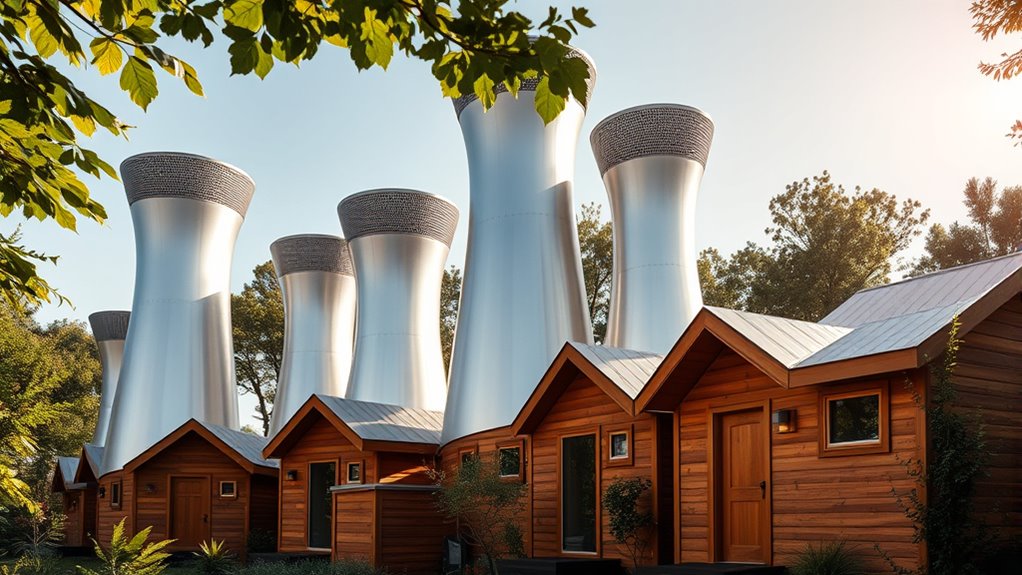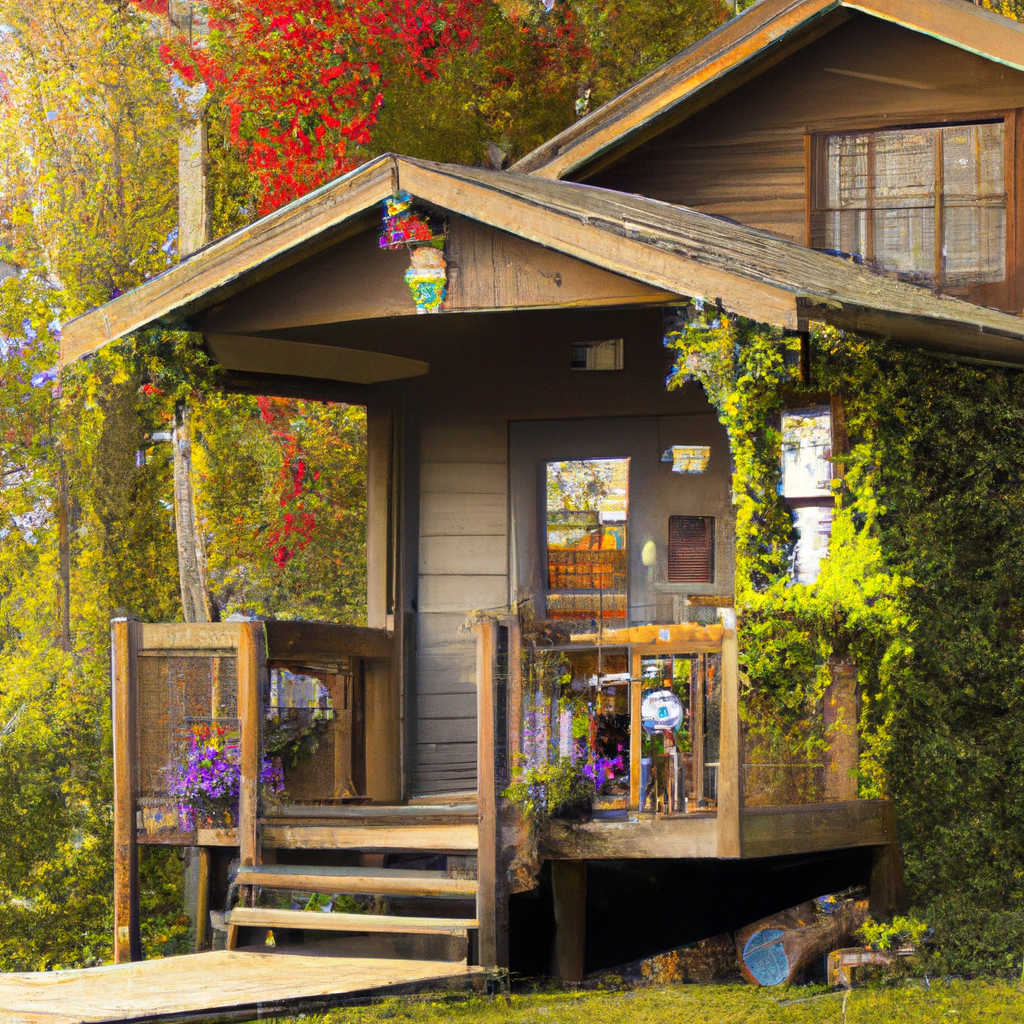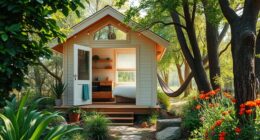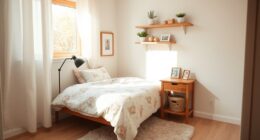Passive ventilation towers use natural convection and wind to cool tiny houses without power. By placing towers high and aligning openings low and high, you create a cycle that pulls in cooler outdoor air and expels warm indoor air. Materials like moisture-resistant woods or metals improve airflow and durability. Combining these towers with insulation and thermal mass enhances comfort. Keep exploring to discover more ways to optimize your tiny home’s natural cooling!
Key Takeaways
- Passive ventilation towers utilize buoyancy and wind flow to naturally circulate air, cooling tiny houses without electrical power.
- Proper placement and height of towers enhance the stack effect, promoting efficient vertical airflow and reducing indoor temperatures.
- Aligning towers with prevailing winds maximizes breeze capture, improving ventilation and cooling performance in tiny homes.
- Using moisture-resistant materials and vapor barriers ensures durability and maintains unobstructed airflow over time.
- Combining passive towers with thermal mass and insulation optimizes temperature regulation and reduces energy needs.
How Passive Ventilation Towers Use Natural Convection
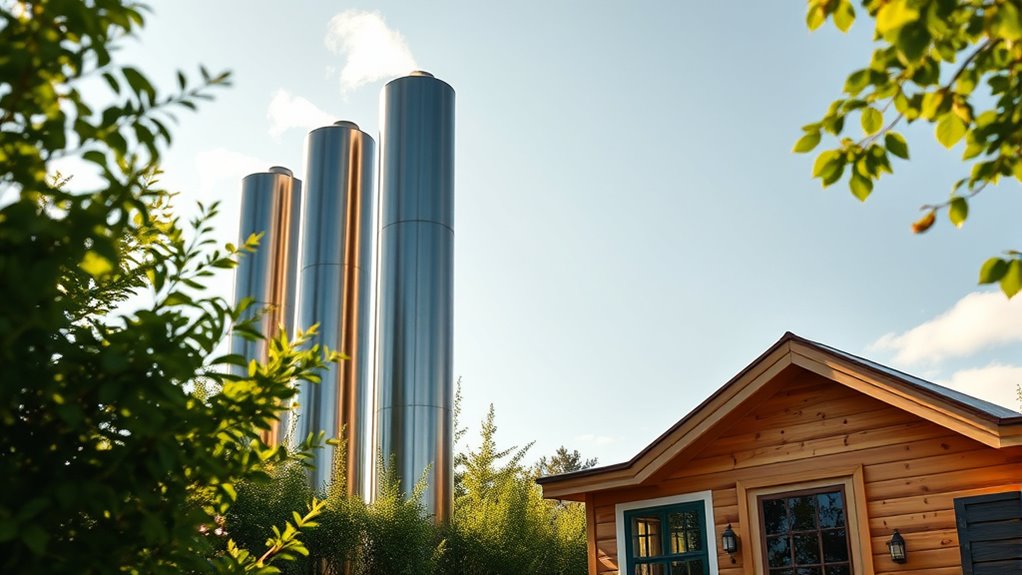
Passive ventilation towers harness natural convection by using temperature differences between indoor and outdoor air to generate airflow. When indoor air heats up, it becomes less dense and rises through the tower’s upper openings, creating buoyancy forces. Cooler, denser outdoor air enters through lower openings, establishing a continuous cycle. The greater the temperature difference, the stronger this airflow becomes. The height of the tower enhances this effect, known as the stack effect, by increasing the pressure difference. As warm air rises and exits, it pulls in cooler air from below, promoting indoor air quality and temperature regulation without mechanical help. Stack effect is a fundamental principle of passive ventilation systems, and the vertical channels or shafts guide this flow naturally, making passive ventilation both effective and energy-efficient. Additionally, airflow dynamics are influenced by the design and placement of the tower, which can optimize the ventilation process further.
Key Design Elements for Effective Ventilation

To guarantee effective ventilation with towers, careful attention must be paid to their orientation, as it directly influences airflow. Align the towers with prevailing winds to harness natural breezes efficiently. In hot climates, position openings to minimize solar heat while maximizing exposure to cooler winds. Place inlet vents low and outlets high to promote cross-ventilation and utilize the stack effect. Incorporate adjustable louvres or ports at the top for seasonal wind adjustments. Use windcatchers or multiple openings to channel airflow into living spaces, and design internal layouts with open-plan areas to reduce resistance. Proper sizing of openings balances airflow with protection from dust and rain, ensuring a steady, comfortable airflow. Understanding passive ventilation principles can greatly enhance natural cooling efficiency in tower design. Additionally, incorporating a variety of ventilation strategies tailored to specific site conditions can optimize airflow and energy efficiency.
Materials That Enhance Airflow and Durability
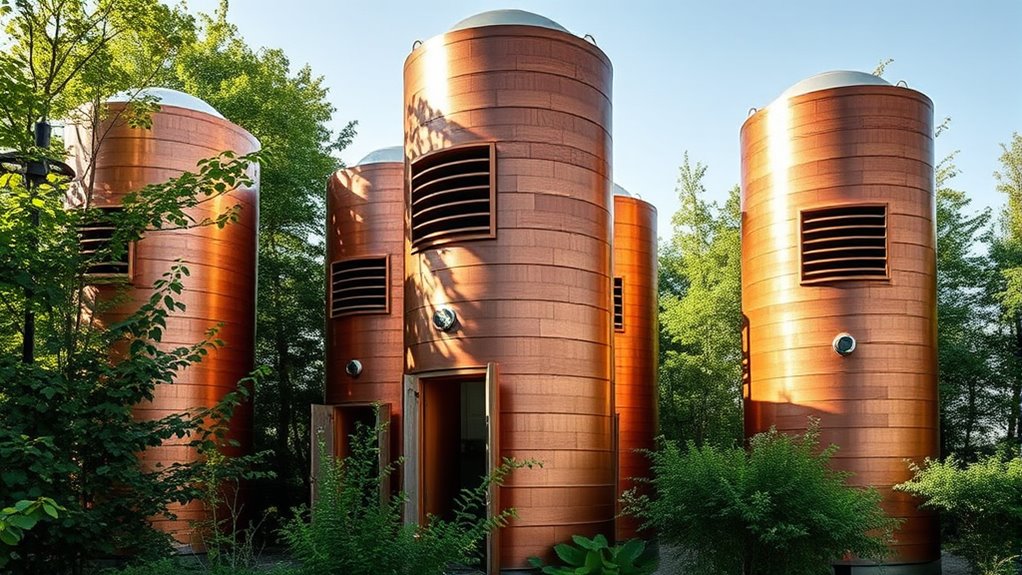
Choosing moisture-resistant and corrosion-resistant materials is essential for ensuring your passive ventilation towers stay durable and effective over time. These materials prevent mold, rot, and rust, keeping airflow unobstructed and the structure intact. Using sustainable, weather-resistant materials like cedar or treated metals can further improve the longevity and environmental resilience of your passive cooling structures. Selecting materials with high thermal conductivity can also optimize airflow efficiency and cooling performance.
Moisture-Resistant Materials
Moisture-resistant materials play a crucial role in enhancing airflow and durability within passive ventilation towers. They prevent moisture intrusion, helping structures dry faster and last longer. Consider these key options:
- Water-Resistive Barriers (WRB): These advanced membranes block inward solar moisture while allowing vapor to escape. They outperform traditional building paper in airflow, drainage, and drying, especially with ventilated air cavities behind them that leverage passive solar energy. Their vapor permeability can be controlled to optimize drying based on environmental conditions.
- Humidity-Variable Vapor Control Membranes: These adapt to indoor humidity, increasing vapor permeability when moisture is high to promote drying. When drier, they tighten to prevent moisture intrusion, consequently reducing mold risks.
- Spray-Applied Barriers (ALMs): These create seamless vapor and moisture barriers, minimizing failure risks at seams. Paired with protective geotextiles, they resist soil damage and improve overall moisture resistance.
Corrosion-Resistant Components
Corrosion-resistant components are essential for maintaining airflow and extending the durability of passive ventilation towers, especially in harsh environments. They prevent material degradation that can block airflow and compromise structural integrity. Metals like galvanized steel, stainless steel, aluminum, copper, and titanium offer varying levels of corrosion resistance, with titanium being the most durable but costly. Polymers such as fiberglass-reinforced plastic (FRP), PVC, and polypropylene combine chemical resistance with lightweight design. Selecting the right material depends on your environment and budget. The table below highlights key properties:
| Material | Strength | Corrosion Resistance | Cost |
|---|---|---|---|
| Galvanized Steel | Moderate | Good with zinc coating | Low |
| Stainless Steel | High | Excellent in humid/chemical environments | High |
| Aluminum | Moderate | Naturally resistant, lightweight | Moderate |
| FRP | High (strength-to-weight) | Very resistant, low maintenance | Moderate |
Additionally, considering the cost-effectiveness of these materials can significantly impact the overall project budget and long-term sustainability.
Combining Towers With Thermal Mass and Insulation
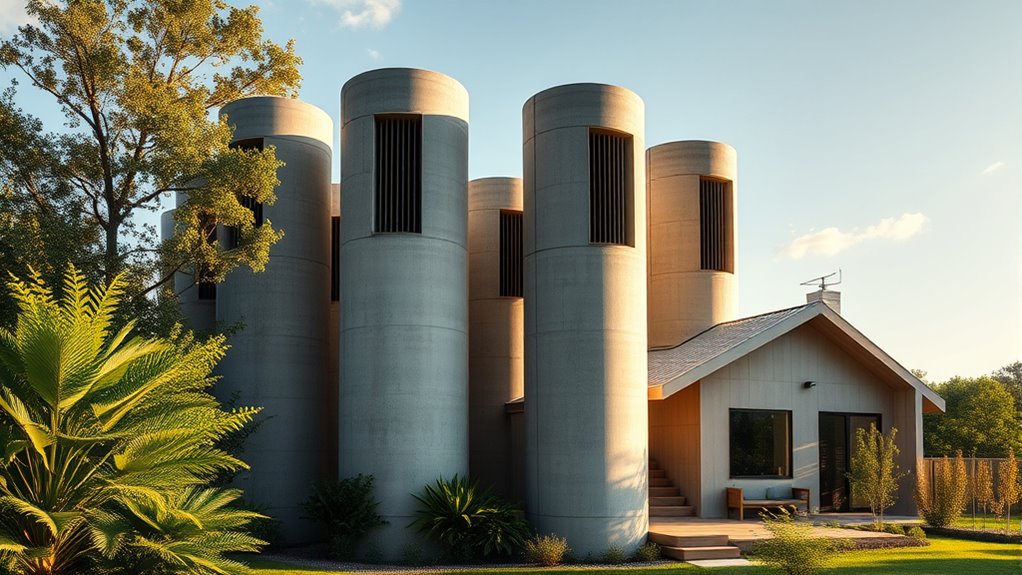
Integrating thermal mass with passive ventilation towers enhances a tiny house’s ability to regulate temperature naturally. By doing so, you leverage the cooling power of night air to recharge thermal mass materials like concrete or phase change materials (PCMs), which absorb and delay indoor temperature rises. This cycle helps to balance indoor temperatures more effectively throughout the day. The combination creates a cycle where:
- Thermal mass retains coolness longer, reducing indoor heat.
- Ventilation towers expel warm, stale air, promoting passive cooling.
- Proper insulation minimizes heat gains and losses, maximizing thermal mass effectiveness.
- Passive cooling strategies can significantly cut energy consumption by reducing the need for active cooling systems, making the house more sustainable.
Positioning thermal mass inside the building envelope ensures it can absorb excess heat efficiently, while insulation controls heat flow. When coordinated, these elements work together to maintain a stable, comfortable indoor environment without relying on power-hungry cooling systems.
Roof and Vent Placement for Optimal Air Circulation
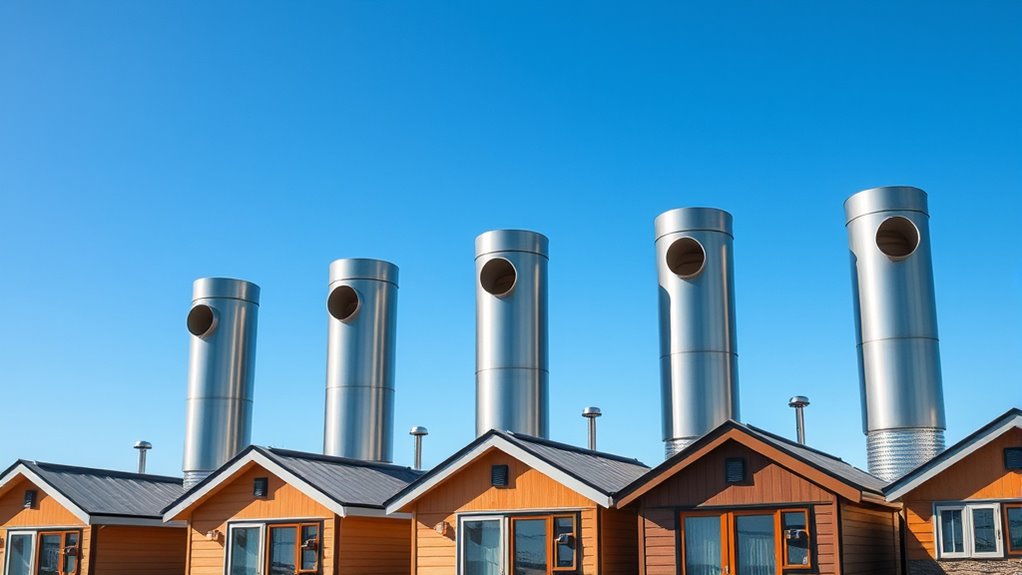
Effective roof and vent placement are essential for maximizing natural air circulation in tiny houses. You should position roof vents where hot air naturally rises, allowing it to escape and draw in cooler air from lower openings. Cross-ventilation is achieved by placing windows or vents on opposite walls, creating a steady flow of fresh air. Soffit vents under eaves help reduce heat buildup and moisture, supporting overall airflow. Proper vent sizing ensures efficient air exchange, preventing stagnation. Louvers and trickle vents can be adjusted for airflow control without drafts. Duct design should prioritize smooth, unobstructed pathways for air movement. Additionally, incorporating natural convection principles can significantly enhance passive cooling efficiency. Combining these strategies ensures you harness natural convection, promoting effective cooling and ventilation without relying on power, and keeps your tiny home comfortable year-round. Proper airflow enhances energy efficiency and indoor air quality.
Benefits for Indoor Air Quality and Humidity Control
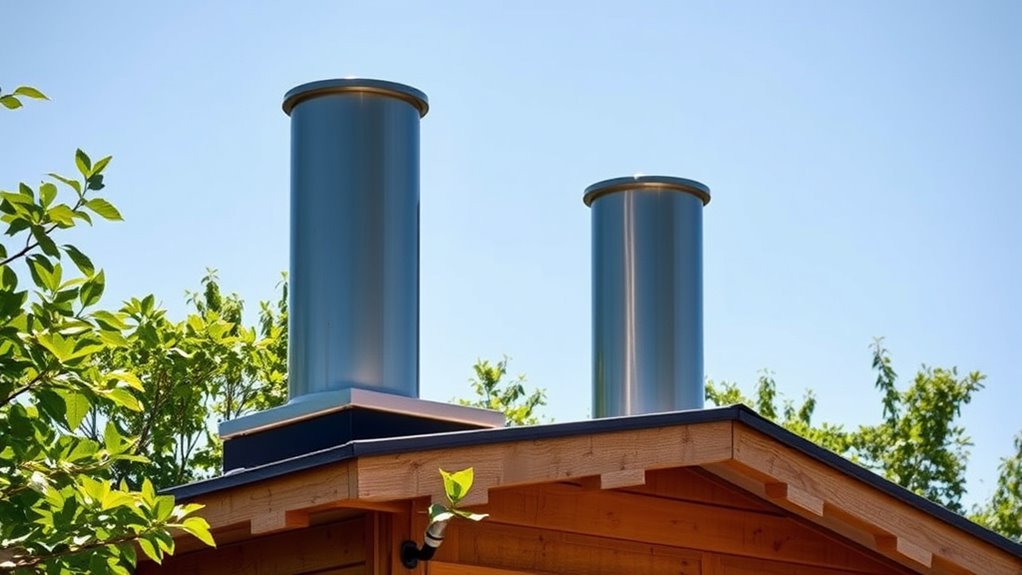
Passive ventilation towers improve indoor air quality by increasing airflow and removing pollutants like dust and pollen. They also help control humidity levels, reducing the risk of mold growth and condensation. With better air circulation and moisture management, you’ll enjoy a healthier, more comfortable indoor environment. Proper ventilation is essential in maintaining a safe and sustainable living space, especially in tiny houses with limited space for traditional HVAC systems. Incorporating effective air exchange techniques can further enhance overall ventilation efficiency.
Improved Air Circulation
Improved air circulation through passive ventilation towers substantially enhances indoor air quality and helps control humidity levels in tiny homes. By facilitating continuous airflow, these towers minimize stagnant air pockets and promote fresh air exchange. Effective placement of vents on opposite walls creates cross-ventilation, allowing air to flow naturally and remove stale air. Roof vents release warm, rising air, encouraging vertical convection currents that boost circulation. Additionally, incorporating passive ventilation towers can significantly reduce reliance on mechanical systems, making them an energy-efficient solution for tiny houses. 1. Low-position vents on cooler sides and high-position vents on warmer sides support natural convection. 2. Combining passive towers with ceiling or extractor fans maintains steady airflow, preventing pollutant buildup. 3. Improved circulation reduces moisture accumulation, lowering mold and mildew risks, and promotes healthier indoor environments. Proper ventilation is essential for maintaining a healthy living space in tiny homes.
This efficient airflow keeps your tiny house fresh, comfortable, and healthier without relying on electricity.
Humidity Reduction Benefits
By promoting continuous airflow, passive ventilation towers help actively reduce indoor humidity levels in tiny homes. They do this by drawing in drier outdoor air and displacing moist indoor air, which lowers humidity. This process improves indoor air quality by removing stale air and introducing fresh air, especially in moisture-prone areas like kitchens and bathrooms. Proper ventilation prevents condensation and mold growth, leading to healthier living conditions. Here’s how it works: High humidity causes damage to insulation, equipment, and buildings, which underscores the importance of effective humidity control. Additionally, integrating Porsche Tuning techniques can optimize ventilation systems for better performance and durability. | Aspect | Benefit | Application |
| ————————– | —————————————————— | —————————— |
|---|---|---|
| Moisture Removal | Reduces humidity, preventing dampness and mold | Venting moist air outside |
| Improved Air Quality | Keeps indoor air fresh and healthier | Replacing stale air |
| Energy Efficiency | Uses natural elements, no power needed | Passive design |
| Adaptability | Fits various tiny house designs | Custom tower setups |
| Long-Term Benefits | Extends structure lifespan by preventing moisture damage | Durable, healthy environment |
Mold Prevention Advantages
Have you ever considered how continuous airflow from ventilation towers can directly prevent mold growth? By increasing air movement, you disrupt mold spores‘ ability to settle and grow. This process also dilutes airborne spores, lowering their concentration and reducing colonization risks. Additionally, improved circulation balances indoor temperatures, minimizing cold spots where condensation occurs. Here are three key benefits:
- Disrupts mold spore settlement and prevents stagnant zones.
- Reduces surface condensation by controlling humidity and temperature fluctuations.
- Expels humid air, helping damp areas dry faster and lowering mold development chances. Proper ventilation promotes constant air exchange, which further enhances humidity control efforts. This natural, energy-free system maintains healthier indoor air quality, supporting mold prevention without relying on power or complex equipment. It’s an effective, sustainable solution for keeping tiny houses mold-free and comfortable.
Off-Grid Efficiency and Sustainability Aspects
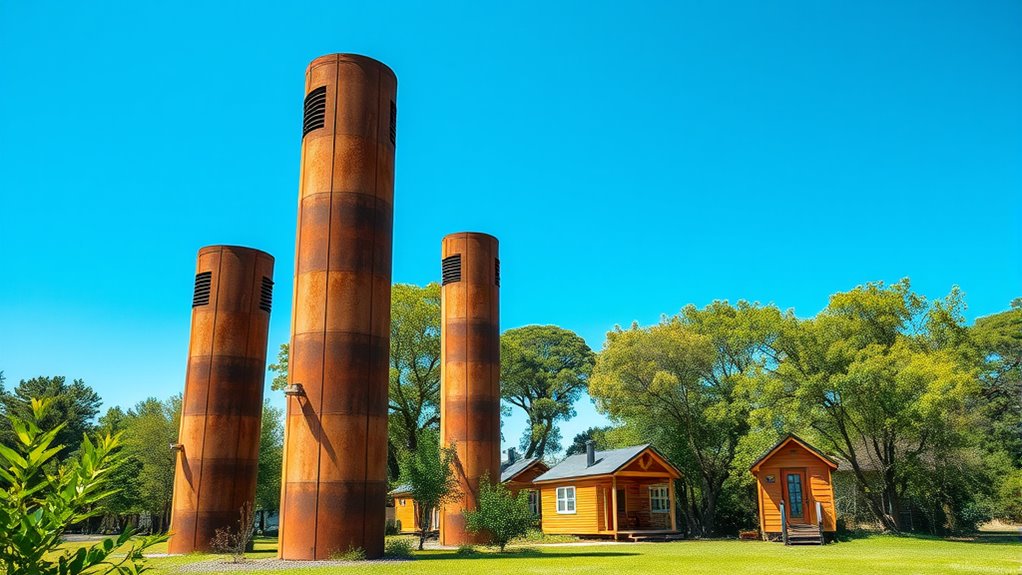
Ever wondered how tiny houses can stay comfortable off the grid without relying on electricity-intensive systems? Passive ventilation towers promote natural airflow, reducing or eliminating the need for powered HVAC systems and lowering energy use. When combined with energy recovery ventilators (ERVs), they exchange indoor air with outdoor air without significant heat loss, minimizing heating and cooling demands. Decentralized ventilation systems optimized for tiny house wall thickness further cut energy waste. Properly sealed and insulated structures, paired with passive airflow, maintain thermal comfort without electrical devices. Heat recovery systems capture thermal energy from outgoing air for reuse. Proper ventilation helps prevent humidity buildup and improves indoor air quality, supporting sustainable living by decreasing reliance on fossil fuels, lowering environmental impact, and conserving resources—making tiny houses truly off-grid efficient and eco-friendly.
Enhancing Comfort and Health in Tiny Living Spaces
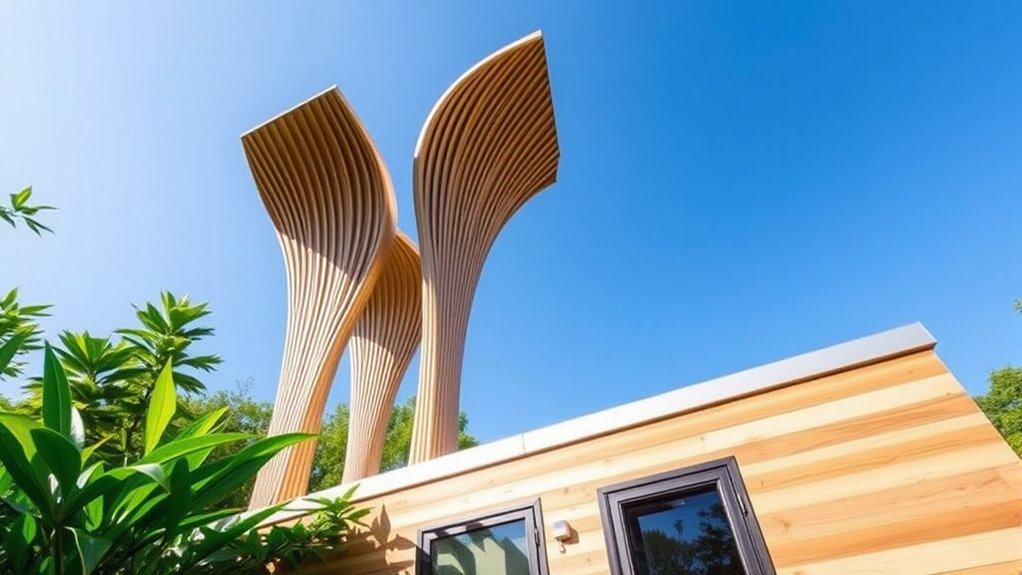
Enhancing comfort and health in tiny living spaces relies heavily on smart design choices and effective ventilation strategies. By implementing these methods, you can create a healthier, more comfortable environment:
- Maximize airflow with cross-ventilation by positioning windows and doors for ideal airflow paths.
- Use passive cooling techniques like reflective roofing and external shading devices to keep temperatures down.
- Improve air quality with proper ventilation, such as roof vents, extractor fans, and energy recovery ventilators (ERVs), which help remove moisture, stale air, and humidity.
- Incorporating no-sugar-added juice brands into your diet can support overall health and hydration, complementing your efforts to maintain a healthy living space.
These strategies reduce mold risks, improve air circulation, and regulate humidity. Combining passive design with mechanical solutions ensures your tiny home stays cool, fresh, and healthy without relying on power-hungry systems.
Frequently Asked Questions
How Do Passive Towers Perform in Extremely Cold Climates?
In extremely cold climates, passive towers struggle to perform well because the small temperature difference between indoors and outdoors limits airflow. You might find that cold air infiltrates, increasing heating needs. To improve performance, you can heighten the tower, add insulation, and use temperature-controlled vents. Incorporating thermal mass and heat recovery systems helps maintain indoor warmth and enhances ventilation, making passive towers more effective despite harsh conditions.
Can Passive Ventilation Towers Be Customized for Different Tiny House Designs?
You can definitely customize passive ventilation towers for your tiny house design. By adjusting size, placement, and vent diameters, you optimize airflow to suit your layout. Incorporate multiple vents at different heights and connect with roof or soffit vents for better convection. Tailor orientation based on wind patterns and climate. Using adaptable materials and adjustable components, you create a ventilation system that fits your aesthetic and functional needs perfectly.
What Maintenance Is Required for Long-Term Tower Performance?
You might think maintenance isn’t necessary once installed, but regular upkeep guarantees long-term performance. You should inspect structural components for cracks or damage, check seals for leaks, and verify foundations haven’t shifted. Clean vents of debris and blockages, monitor airflow, and replace weather-damaged parts with durable materials. Keep detailed records of inspections and repairs, especially after extreme weather, to catch issues early and keep your passive ventilation system working efficiently over time.
Are There Any Building Code Restrictions for Installing Passive Towers?
You should know that building codes do impose restrictions on installing passive towers. These include sizing ventilation openings correctly, ensuring proper placement for airflow, and preventing interference with fire safety or smoke control requirements. Local codes might have specific rules, so you need to verify them. Also, your installation must meet standards for energy efficiency, indoor air quality, and structural safety, ensuring the passive system functions effectively without compromising building safety or compliance.
How Effective Are Towers During High Humidity or Rainy Seasons?
During high humidity or rainy seasons, passive towers become less effective at cooling because the moist air limits evaporative cooling. You’ll find that airflow helps more with ventilation than temperature reduction. To manage indoor humidity, you should use cross-ventilation and guarantee proper maintenance of vents and drainage. Combining passive towers with mechanical systems, like HRVs, can better control moisture and improve comfort during wet weather.
Conclusion
Passive ventilation towers offer a simple, sustainable way to keep your tiny house cool without electricity. By harnessing natural convection and smart design, you enhance air quality, control humidity, and improve comfort. Isn’t it time you considered a solution that’s environmentally friendly and cost-effective? Embracing these towers means you’re not just cooling your space—you’re making a smarter, greener choice for your lifestyle and the planet. Isn’t that the kind of living space you want to create?
I’m Theodore, and I love tiny houses. In fact, I’m the author of Tiny House 43, a book about tiny houses that are also tree houses. I think they’re magical places where imaginations can run wild and adventures are just waiting to happen.
While tree houses are often associated with childhood, they can be the perfect adult retreat. They offer a cozy space to relax and unwind, surrounded by nature. And since they’re typically built on stilts or raised platforms, they offer stunning views that traditional homes simply can’t match.
If you’re looking for a unique and romantic getaway, a tree house tiny house might just be the perfect option.
